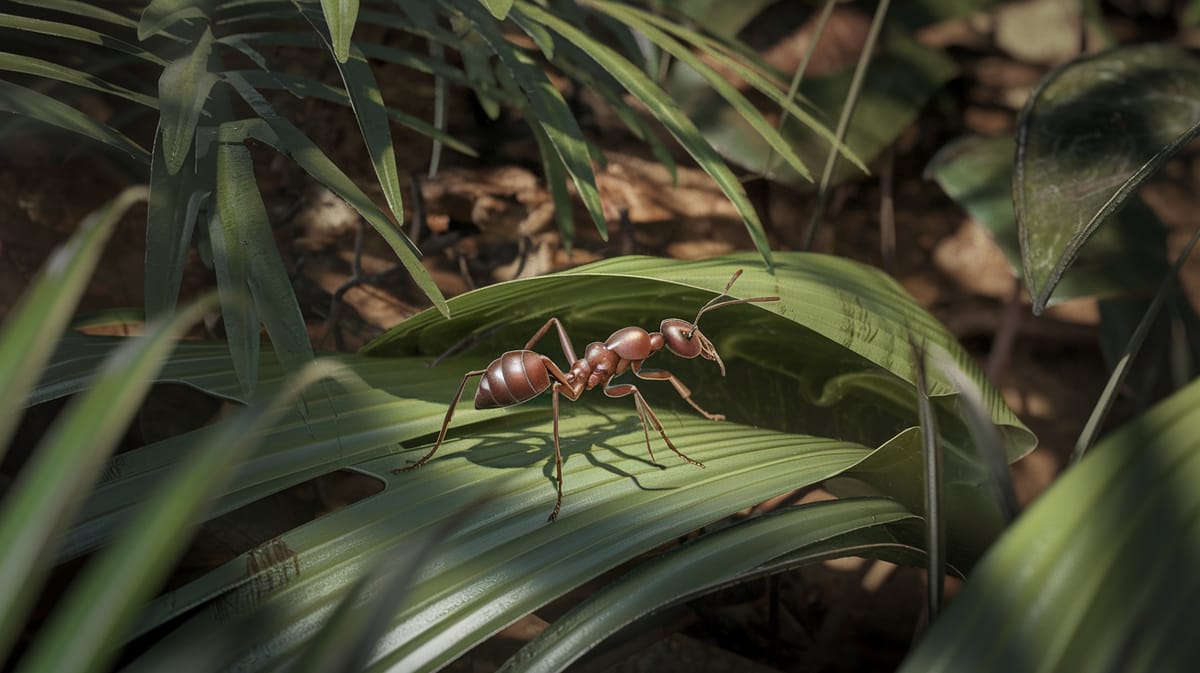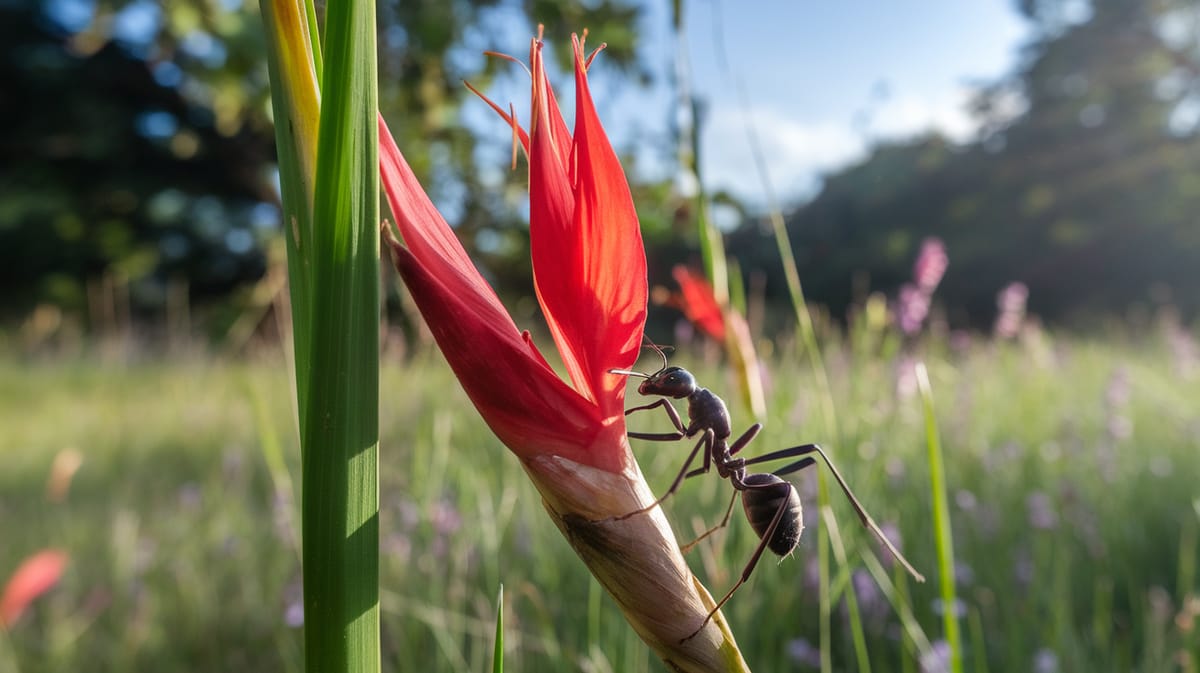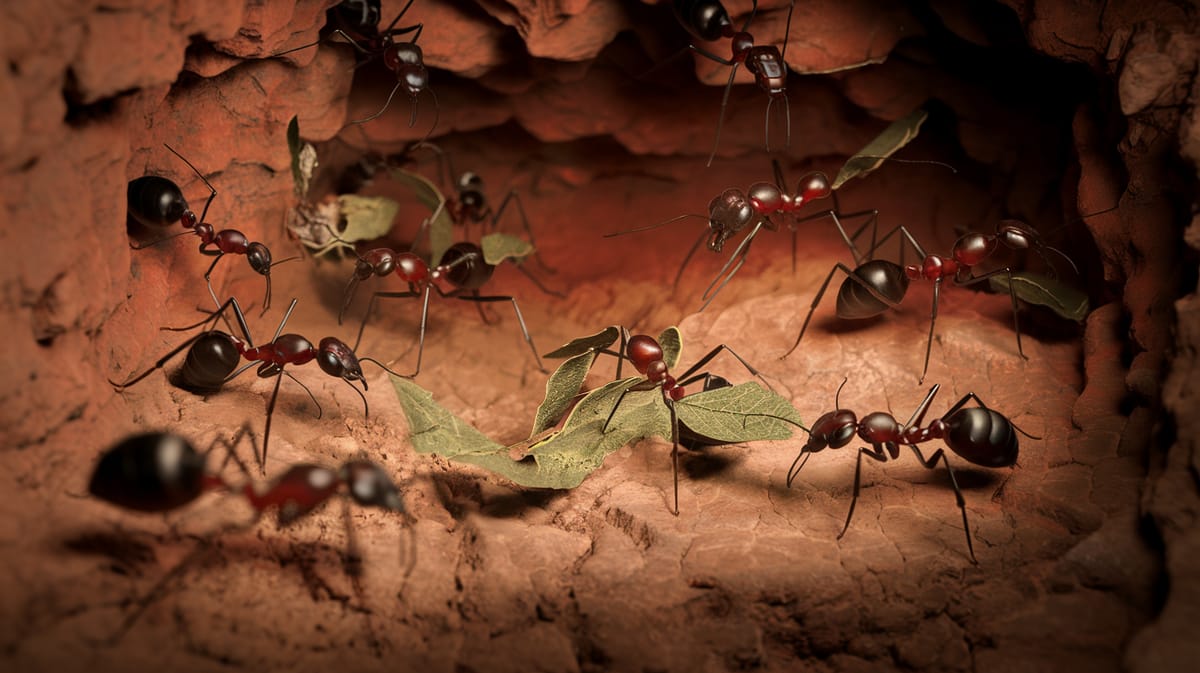Leafcutter ant
Renowned for their farming skills, Leafcutter ants cultivate fungus gardens with precision and teamwork. These industrious insects play a vital role in enriching soil ecosystems.

Key Insights at a Glance
Did You Know?
Taxonomy & Classification
Leafcutter ants exhibit remarkable agricultural skills, cultivating fungus gardens from leaf fragments. This unique behavior highlights their advanced social structure and ecological impact. Let's understand the evolutionary journey and classification of these remarkable herbivores, decomposers.
Species Diversity
Leafcutter ants include around 47 species within the genus Atta, primarily found in tropical and subtropical regions of the Americas.
Evolutionary Adaptations
Originating about 10 million years ago, leafcutter ants have thrived by adapting to symbiotic relationships with fungi, ensuring survival through environmental changes.
Lifecycle and Growth
A remarkable journey of transformation from Egg to Adult.
Egg
Eggs are laid by the queen and are kept in a controlled environment by worker ants to ensure optimal growth.
Larva
Larvae are fed chewed leaves by workers, growing rapidly and preparing for the next transformation.
Pupa
Pupae are immobile and undergo metamorphosis, emerging as fully formed adults ready to join the colony.
Adult
Adults assume specific colony roles, from foraging to defending the nest, contributing to the colony's complex social structure.
Dietary Habits
A remarkable cultivator, this insect primarily relies on its unique ability to farm and consume fungus from gathered plant material.
| DIET TYPE | DESCRIPTION |
|---|---|
| Primary Diet | Harvests leaves to cultivate a specialized fungus, serving as its main food source. |
| Secondary Diet | Occasionally chews plant sap and juices to supplement its diet during specific conditions. |
| Occasional | Rarely consumes actual plant material directly for sustenance, mainly when fungus resources are scarce. |

Behaviour and Adaptations
Discover the fascinating abilities that make Leafcutter ants nature's extraordinary agriculturalists.
Fungal Farming
Leafcutter ants cultivate fungus using chewed leaves as a substrate.
Efficient Leaf Transport
Workers cut and carry leaf fragments back to the nest with remarkable efficiency.
Chemical Communication
Use pheromones to coordinate and manage complex colony activities.
Ecosystem Impact
Leafcutter ants play a crucial role in sustaining and enriching their ecosystem.
Soil Aerators
They enhance soil quality by turning soil as they forage.
Fungal Farmers
Cultivates fungus as a food source, supporting biodiversity.
Nutrient Cyclers
Recycles plant material, returning nutrients to the soil.
Conservation Challenges
Addressing the major threats to Leafcutter ant populations and ecosystems.
Habitat Destruction
Deforestation and urbanization reduce the ants' forest habitats, affecting their survival.
Climate Change
Altered rainfall patterns and temperatures disrupt the ants' ecosystem balance and food supply.
Pesticide Use
Chemical pesticides harm Leafcutter ants and their fungal gardens.
Frequently Asked Questions
How long do Leafcutter ant live?
Leafcutter ants can live for different lengths of time depending on their role. Worker ants typically live a few months, while queens can live for several years, sometimes over a decade, depending on environmental conditions and colony success.
What do Leafcutter ant eat?
Leafcutter ants primarily feed on fungus, which they cultivate in their nests. They cut leaves and other plant material to serve as the substrate for growing this fungus, which is their primary food source.
Are Leafcutter ant poisonous?
Leafcutter ants are not poisonous. They pose little threat to humans as they do not have venom. Their primary defense mechanism is their strong mandibles, which they use to cut leaves and defend their colony.
Are Leafcutter ant endangered?
Leafcutter ants are not considered endangered. They are widespread in their native habitats, which include tropical regions of Central and South America. They play a vital ecological role in these areas by recycling plant material.
What do Leafcutter ant symbolize?
Leafcutter ants often symbolize hard work, teamwork, and efficiency. Their complex social structure and ability to cultivate fungus for food are seen as examples of cooperation and diligence in nature.
Do Leafcutter ant bite?
Yes, Leafcutter ants can bite. They use their strong mandibles to cut leaves and defend their colony. While their bite can be painful, it is not harmful to humans and does not involve venom.
What color are Leafcutter ant?
Leafcutter ants vary in color but are typically reddish-brown. The exact shade can differ based on the species and environmental factors. Their coloration helps them blend into their surroundings, offering some protection from predators.
Does a Leafcutter ant have wings?
Only reproductive members of a Leafcutter ant colony, such as queens and males, have wings. These ants use their wings to fly during mating flights. Worker ants do not have wings and remain in the colony to perform various tasks.
What does a Leafcutter ant look like?
Leafcutter ants have a segmented body with a distinct head, thorax, and abdomen. They have strong mandibles for cutting leaves and antennae for sensing their environment. Their size can range from 2 to 18 mm, depending on their role in the colony.
Is a Leafcutter ant an insect?
Yes, a Leafcutter ant is an insect. Like all insects, they have a three-part body structure: head, thorax, and abdomen, six legs, and antennae. They belong to the family Formicidae, which includes all ant species.
Related Insects
Discover insects with similar characteristics to Leafcutter ant - including shared habitats, diets, and taxonomic classifications
Share this profile
Help others discover Leafcutter ant
